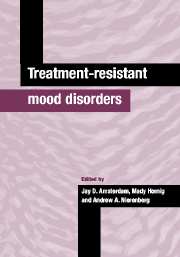Preface
Published online by Cambridge University Press: 25 March 2010
Summary
As many as 60–70% of depressed patients fail to achieve complete remission. In its broadest sense, treatment-resistant depression (TRD) characterizes the vast majority of depressed patients in therapy, and substantially contributes to the overwhelming morbidity and mortality associated with depressive illness. TRD is now recognized as a major public health problem which accounts for a disproportionate amount of physician treatment time, and as much as $50 billion in annualized healthcare expenditures (Greenberg et al., 1993).
The paucity of systematic data on TRD has led to inconsistent definitions and treatment approaches. While ad hoc definitions of TRD have been used to identify patients for specific treatment studies, the clinical applicability of these definitions is limited (Souery et al., 1999). Almost three decades after its initial description, TRD continues to be ‘an important clinical problem that is surprisingly understudied. The decision regarding what to do for patients who fail to respond to an adequate trial of an antidepressant must be made by a clinician without the benefit of controlled studies that compare subsequent treatment strategies.’ (Nierenberg, 1991).
The lack of response to initial antidepressant treatment has important clinical implications and results in considerable suffering and an increased risk of suicide. The recent demonstration of a ‘therapeutic decrement,’ whereby patients who have not responded to one antidepressant drug will have 20% less likelihood of responding to the next drug treatment (Amsterdam & Maislin, 1994) has critical treatment implications. It suggests that the current clinical practice of prescribing low doses of antidepressants for brief periods may, in itself, contribute to the development of TRD.
- Type
- Chapter
- Information
- Treatment-Resistant Mood Disorders , pp. xv - xviiiPublisher: Cambridge University PressPrint publication year: 2001



